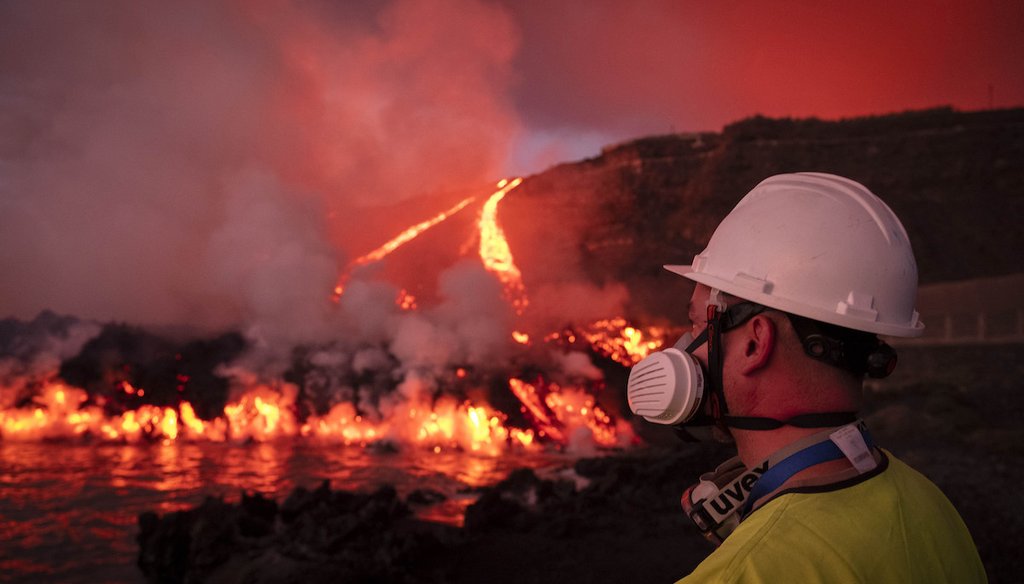

Our only agenda is to publish the truth so you can be an informed participant in democracy.
We need your help.


A scientist watches lava flows from a volcano reach the sea on the Canary island of La Palma, Spain, Nov. 11, 2021. (AP)
• The ongoing eruption of the volcano on La Palma island is not evidence that it might collapse. Eruptions of Canary Island volcanoes are not uncommon, while collapses are rare and typically happen incrementally, not at all once.
• If La Palma volcano were to collapse suddenly, the resulting waves along the eastern coast of the United States would likely be 3 to 7 feet high, similar to a common storm surge.
The ongoing eruption of a volcano on La Palma in the Canary Islands — about 3,000 miles across the Atlantic Ocean from the eastern U.S. coast — has triggered claims that a catastrophic volcanic collapse and tsunami could be in the cards.
A viral video features an unidentified man saying, "I’m showing a map of the East Coast of the United States … all the way up into Canada. Because if that land mass breaks off from La Palma volcano, there would be no tsunami sirens, there will be no notification because the Biden administration doesn’t want to tell anybody." It included text that said, "Flood map for East Coast in 50 meters = 160 foot wave."
The video originated on TikTok but was shared via Facebook, and it was flagged as part of Facebook’s efforts to combat false news and misinformation on its News Feed. (Read more about our partnership with Facebook.)
Government scientists say the claims in the video exaggerate the threat to the U.S., and we found no evidence to back the claim that the Biden administration is withholding necessary warnings.
The eruption on La Palma is not evidence that the volcano might collapse. Eruptions of Canary Island volcanoes are not uncommon, and the La Palma volcano also erupted in 1949 and 1971.
Even if the volcano collapsed, the resulting waves along the eastern coast of the United States would likely be 3 to 7 feet high, similar to a common storm surge, according to the U.S. Geological Survey, part of the Department of the Interior.
And those waves would occur only if the collapse happened all at once and very quickly, which scientists say is unlikely. Collapses typically occur in "incremental or piecemeal fashion," according to the USGS.
In general, volcanic collapses on the Canary Islands are rare, "occurring on timescales of hundreds of thousands of years," the USGS said.
The Canary Islands are governed by Spain and located off the coast of northwest Africa. The volcano on La Palma island began erupting on Sept. 19 and has continued since, with some brief pauses.
The idea of a "mega tsunami" originating in the Canary Islands and encompassing an entire ocean dates to a 2001 academic paper that suggested if La Palma collapsed, the east coasts of North and South America could experience tsunami waves up to 80 feet high.
But USGS scientists say the hypothesis "doesn’t carry water." Technology for modeling tsunamis is much more advanced now than in 2001. The newer technology was used to more accurately estimate the maximum wave height — 3 to 7 feet — that would be expected in a worst-case scenario.
The National Tsunami Warning Center also weighed in on Sept. 19 to say, "There is NO tsunami danger for the U.S. East Coast at this time, following the eruption of Cumbre Vieja volcano, La Palma, Canary Islands. The National Tsunami Warning Center is monitoring this situation, and based on all available data, including nearby water level observations, there is no tsunami hazard for the U.S. East Coast."
The warning center said tsunami alerts are disseminated through National Weather Service and broadcast through official emergency alert channels.
The claim that the Biden administration would withhold any warning is unsupported.
A video shared on Facebook shows an unidentified man warning of a major tsunami threat resulting from the La Palma volcano eruption, with a 160-foot wave and no warnings.
The National Tsunami Warning Center said that it’s monitoring the volcano and that there is no tsunami hazard for the U.S. East Coast from the La Palma volcano.
Volcano collapses are rare and unlikely to happen all at once. If La Palma were to collapse quickly, the eastern coast of the United States would likely experience waves between 3 and 7 feet high, similar to common storm surge.
We rate this claim False.
Euro News, "La Palma volcano: Activity 'intense' after recent lull, say scientists," Dec. 2, 2021
Facebook post, Sept. 19, 2021
Facebook post, Nov. 29, 2021
United States Geological Survey, "Volcano Watch — The Canary Islands ‘mega-tsunami’ hypothesis, and why it doesn’t carry water," Oct. 21, 2021
In a world of wild talk and fake news, help us stand up for the facts.
